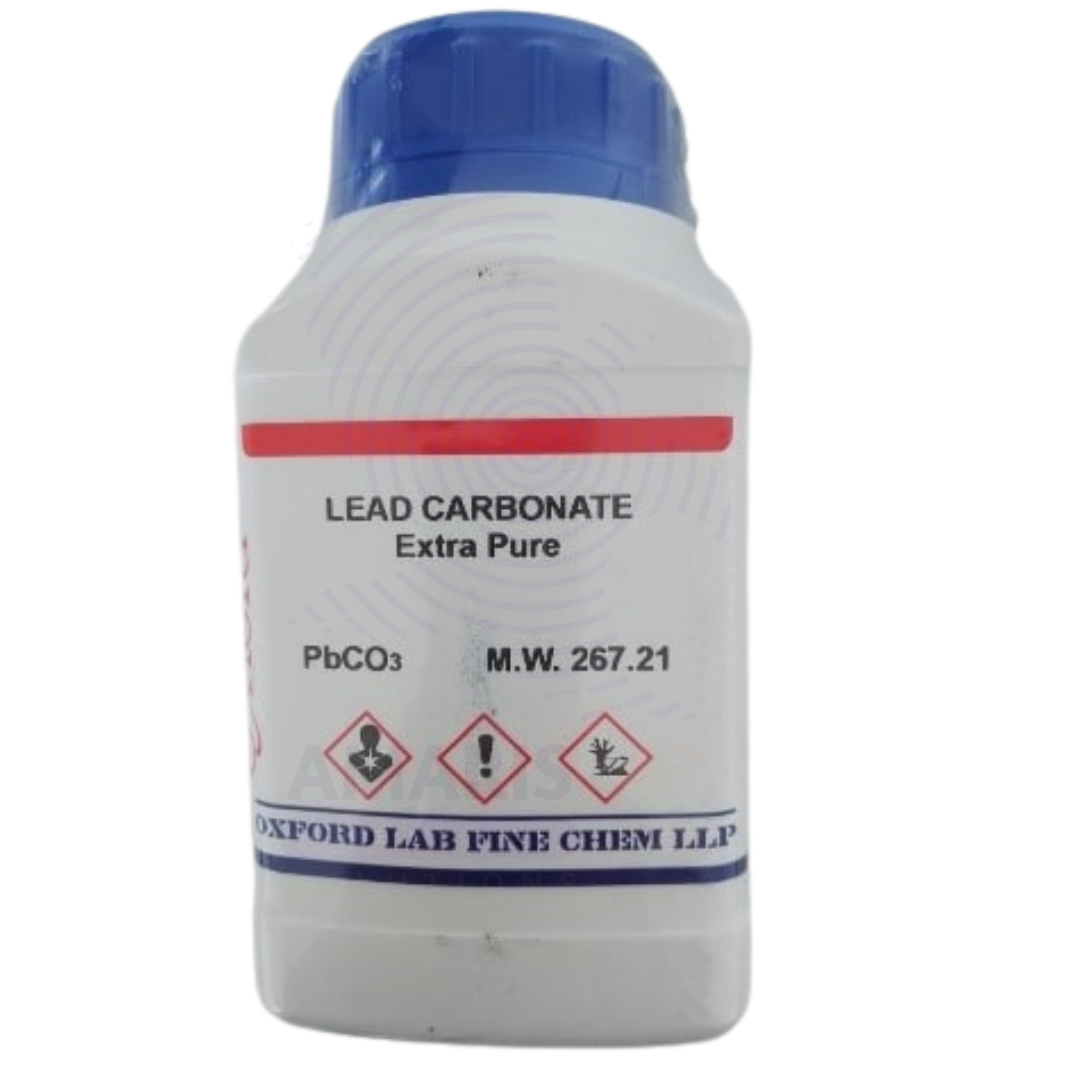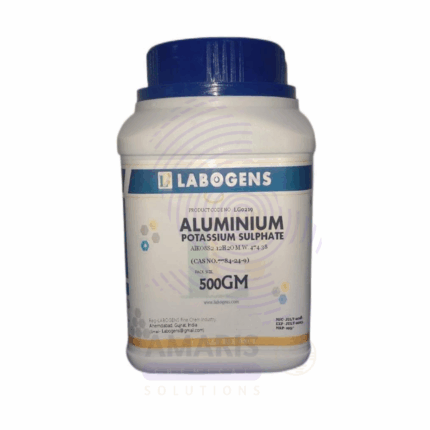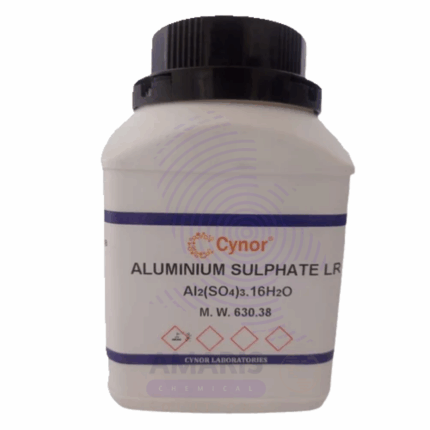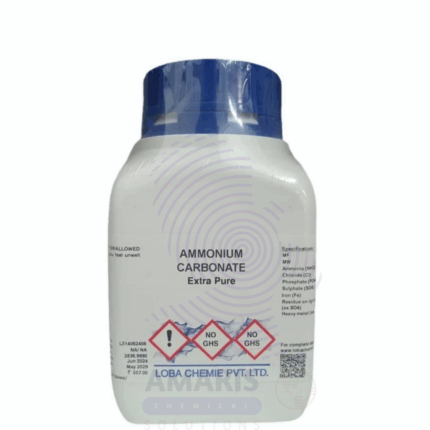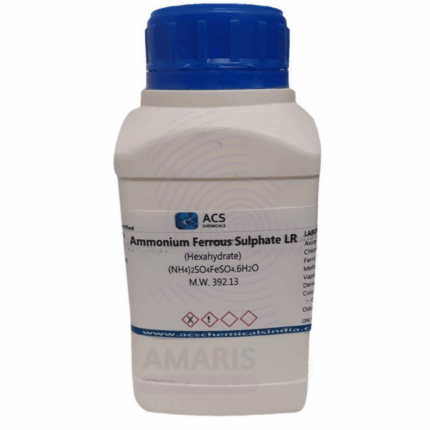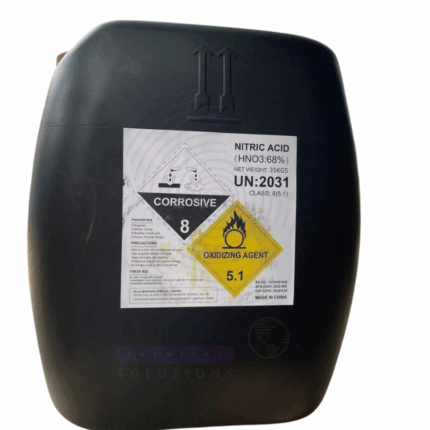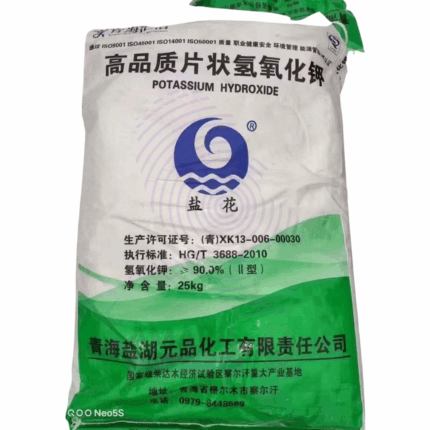
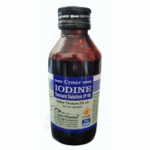
Lead Carbonate Extra Pure
$ 17.75 Original price was: $ 17.75.$ 17.67Current price is: $ 17.67.
Lead Carbonate Extra Pure is a fine white powder with the chemical formula PbCO₃, valued for its high purity and stability. Historically known as “white lead,” it has been used as a pigment in paints, though this application is now limited due to its toxicity. In modern laboratory and industrial settings, it is primarily used in chemical synthesis, ceramics, and material science research. Lead carbonate plays a role in catalyst preparation and in the manufacture of other lead compounds. Its insolubility in water makes it useful in specific controlled-reaction systems. Proper protective measures are essential when handling this compound due to the health risks associated with lead exposure.
Lead Carbonate Extra Pure
Primary Uses
- Pigment Research (White Lead Studies):
Studied as a historical white pigment in art conservation and materials analysis due to its role in traditional paints. - Analytical Chemistry (Lead Source):
Used as a standard source of lead (Pb²⁺) ions in various qualitative and quantitative experiments.
Secondary Uses
- Thermal Decomposition Experiments:
Investigated for decomposition into lead oxide and carbon dioxide at elevated temperatures—relevant in materials science. - Ceramic and Glass Studies:
Occasionally evaluated in formulation of lead-based glazes or glasses under controlled academic or industrial research. - Toxicology and Environmental Studies:
Used in controlled toxicological experiments and soil contamination simulation for studying lead behavior in the environment.
| PACK SIZE |
500 grams Plastic Tin |
|---|
1. Basic Identification Attributes
- Chemical Name: Lead(II) Carbonate
- Synonyms: Cerussite, Plumbous carbonate
- Chemical Formula: PbCO₃
- CAS Number: 598-63-0
- Molecular Weight: 267.21 g/mol
- Grade: Extra Pure (suitable for analytical and lab use)
- Appearance: White or off-white fine powder
- Odor: Odorless
- Solubility: Insoluble in water; soluble in nitric and acetic acids
- Melting Point: Decomposes at high temperature without melting
2. Safety & Hazard Attributes
- GHS Classification:
- Acute Toxicity – Category 4 (oral)
- Reproductive Toxicity – Category 1A
- Specific Target Organ Toxicity (Repeated Exposure) – Category 2
- Aquatic Chronic – Category 2
- Hazard Statements:
- H302: Harmful if swallowed
- H360: May damage fertility or the unborn child
- H373: May cause damage to organs through prolonged or repeated exposure
- H411: Toxic to aquatic life with long lasting effects
- Precautionary Statements:
- P201: Obtain special instructions before use
- P261: Avoid breathing dust
- P280: Wear protective gloves, clothing, and eye/face protection
- P273: Avoid release to the environment
- P301+P312: IF SWALLOWED: Call a POISON CENTER if you feel unwell
- Personal Protective Equipment (PPE):
- Lab coat
- Chemical-resistant gloves (e.g., nitrile)
- Safety goggles or face shield
- Dust respirator if ventilation is poor
- First Aid Measures:
- Inhalation: Move to fresh air; seek medical attention
- Skin Contact: Wash with soap and water
- Eye Contact: Rinse cautiously with water for several minutes
- Ingestion: Rinse mouth; do not induce vomiting; seek immediate medical help
- Fire Hazards:
- Non-flammable
- Extinguishing Media: Use appropriate media for surrounding fire
- Avoid breathing decomposition fumes which may include lead oxides
3. Storage & Handling Attributes
- Storage Conditions:
- Store in a tightly sealed container
- Keep in a dry, cool, well-ventilated place
- Segregate from food, acids, and incompatible substances
- Clearly label as toxic; restrict access to trained personnel
- Handling Tips:
- Handle in a fume hood
- Minimize dust generation and accumulation
- Follow hazardous waste disposal protocols
4. Laboratory Applications
- Primary Uses:
- Used in inorganic chemistry experiments involving lead salts
- Precursor in pigment manufacturing studies (historically white lead)
- Analytical reagent for lead detection and complexation studies
- Secondary Uses:
- Used in materials research, especially ceramics and glass
- Occasionally used in historical pigment and corrosion research
- Demonstration of carbonate decomposition reactions
SAFETY PRECAUTIONS
Personal Protective Equipment (PPE):
- Wear a lab coat, chemical-resistant gloves (nitrile or neoprene), and safety goggles.
- Use a NIOSH-approved respirator or operate in a certified fume hood to avoid inhaling dust.
- Avoid direct skin or eye contact.
Handling:
- Handle with extreme caution—highly toxic if ingested or inhaled.
- Avoid generating or breathing dust.
- Prevent contamination of surfaces or clothing.
- Wash hands and face thoroughly after handling.
- Do not eat, drink, or smoke while handling this chemical.
Storage:
- Store in a tightly closed container in a cool, dry, well-ventilated area.
- Keep away from acids, moisture, and incompatible substances.
- Label as TOXIC and restrict access.
FIRST AID MEASURES
Inhalation:
- Move the affected person to fresh air immediately.
- Keep them warm and at rest.
- Seek emergency medical attention if symptoms like coughing or dizziness occur.
Skin Contact:
- Remove contaminated clothing.
- Wash skin with plenty of water and soap for at least 15 minutes.
- Seek medical help if irritation or symptoms persist.
Eye Contact:
- Rinse cautiously with water for several minutes.
- Remove contact lenses if easy to do.
- Continue rinsing and get immediate medical attention.
Ingestion:
- Rinse your mouth thoroughly.
- Do NOT induce vomiting.
- Seek urgent medical attention—lead carbonate is highly toxic if swallowed.
FIRE FIGHTING MEASURES
Flammability:
- Non-flammable, but decomposes at high temperatures.
Extinguishing Media:
- Use dry chemicals, foam, or CO₂.
- Water spray may be used for cooling, but avoid runoff.
Hazardous Combustion Products:
- May release toxic lead oxides and carbon monoxide/dioxide when decomposed in fire.
Firefighter Protection:
- Wear full protective gear and self-contained breathing apparatus (SCBA).
- Avoid inhaling smoke, fumes, or dust.
Related products
Alizarin Extra Pure
Aluminium Potassium Sulphate Hydrated Extra Pure
Aluminium Sulphate Anhydrous Extra Pure
Ammonium Carbonate Extra Pure
Ammonium Carbonate Extra Pure is a high-quality, white crystalline solid widely used across various scientific, industrial, and food-related applications. Manufactured to stringent purity standards, this compound is ideal for laboratories and processes that demand high-grade reagents. With its characteristic ammonia-like odor and ability to decompose upon heating, ammonium carbonate plays a versatile role in both chemical reactions and physical processes.
In aqueous solution, ammonium carbonate breaks down into ammonium bicarbonate and ammonium carbamate, further releasing ammonia (NH₃) and carbon dioxide (CO₂) upon heating. This property makes it especially useful in applications that require controlled gas release or temporary pH modification.


 Preservatives(food)
Preservatives(food) Flavor Enhancers
Flavor Enhancers Acidulants
Acidulants Sweeteners
Sweeteners Antioxidants
Antioxidants Colorants(food)
Colorants(food) Nutraceutical Ingredients (food)
Nutraceutical Ingredients (food) Nutrient Supplements
Nutrient Supplements Emulsifiers
Emulsifiers
 Collectors
Collectors Dust Suppressants
Dust Suppressants Explosives and Blasting Agents
Explosives and Blasting Agents Flocculants and Coagulants
Flocculants and Coagulants Frothers
Frothers Leaching Agents
Leaching Agents pH Modifiers
pH Modifiers Precious Metal Extraction Agents
Precious Metal Extraction Agents
 Antioxidants(plastic)
Antioxidants(plastic) Colorants (Pigments, Dyes)
Colorants (Pigments, Dyes) Fillers and Reinforcements
Fillers and Reinforcements Flame Retardants
Flame Retardants Monomers
Monomers Plasticizers
Plasticizers Polymerization Initiators
Polymerization Initiators Stabilizers (UV, Heat)
Stabilizers (UV, Heat)
 Antifoaming Agents
Antifoaming Agents Chelating Agents
Chelating Agents Coagulants and Flocculants
Coagulants and Flocculants Corrosion Inhibitors
Corrosion Inhibitors Disinfectants and Biocides
Disinfectants and Biocides Oxidizing Agents
Oxidizing Agents pH Adjusters
pH Adjusters Scale Inhibitors( water)
Scale Inhibitors( water)
 Antioxidants(cosmetic)
Antioxidants(cosmetic) Emollients
Emollients Fragrances and Essential Oils
Fragrances and Essential Oils Humectants
Humectants Preservatives
Preservatives Surfactants(cosmetic)
Surfactants(cosmetic) Thickeners
Thickeners UV Filters
UV Filters
 Fertilizers
Fertilizers Soil Conditioners
Soil Conditioners Plant Growth Regulators
Plant Growth Regulators Animal Feed Additives
Animal Feed Additives Biostimulants
Biostimulants Pesticides (Herbicides, Insecticides, Fungicides)
Pesticides (Herbicides, Insecticides, Fungicides)
 Active Pharmaceutical Ingredients (APIs)
Active Pharmaceutical Ingredients (APIs) Excipients
Excipients Solvents(pharmaceutical)
Solvents(pharmaceutical) Antibiotics
Antibiotics Antiseptics and Disinfectants
Antiseptics and Disinfectants Vaccine Adjuvants
Vaccine Adjuvants Nutraceutical Ingredients (pharmaceutical)
Nutraceutical Ingredients (pharmaceutical) Analgesics & Antipyretics
Analgesics & Antipyretics
 Analytical Reagents
Analytical Reagents Solvents(lab)
Solvents(lab) Chromatography Chemicals
Chromatography Chemicals Spectroscopy Reagents
Spectroscopy Reagents microbiology-and-cell-culture-reagents
microbiology-and-cell-culture-reagents Molecular Biology Reagents
Molecular Biology Reagents Biochemical Reagents
Biochemical Reagents Inorganic and Organic Standards
Inorganic and Organic Standards Laboratory Safety Chemicals
Laboratory Safety Chemicals Specialty Laboratory Chemicals(Special Laboratory Equipment)
Specialty Laboratory Chemicals(Special Laboratory Equipment)
 Demulsifiers
Demulsifiers Hydraulic Fracturing Fluids
Hydraulic Fracturing Fluids Scale Inhibitors(oil)
Scale Inhibitors(oil) Surfactants(oil)
Surfactants(oil) Drilling Fluids
Drilling Fluids
 Dyes and Pigments
Dyes and Pigments Bleaching Agents
Bleaching Agents Softening Agents
Softening Agents Finishing Agents
Finishing Agents Antistatic Agents
Antistatic Agents
 Admixtures
Admixtures Waterproofing Agents
Waterproofing Agents Sealants and Adhesives
Sealants and Adhesives Curing Compounds
Curing Compounds Concrete Repair Chemicals
Concrete Repair Chemicals Anti-Corrosion Coatings
Anti-Corrosion Coatings
 Surfactants(cleaning)
Surfactants(cleaning) Builders
Builders Enzymes
Enzymes Solvents (Cleaning)
Solvents (Cleaning) Fragrances
Fragrances
 Electronic Chemicals
Electronic Chemicals Catalysts
Catalysts Lubricants
Lubricants Photographic Chemicals
Photographic Chemicals Refrigerants
Refrigerants Automotive chemicals
Automotive chemicals Pyrotechnic Chemicals
Pyrotechnic Chemicals
 Biodegradable Surfactants
Biodegradable Surfactants Bio-based Solvents
Bio-based Solvents Renewable Polymers
Renewable Polymers Carbon Capture Chemicals
Carbon Capture Chemicals Wastewater Treatment Chemicals
Wastewater Treatment Chemicals
 Pigments
Pigments Solvents(paint)
Solvents(paint) Specialty Coatings
Specialty Coatings Binders/Resins
Binders/Resins Additives
Additives Driers
Driers Anti-Corrosion Agents
Anti-Corrosion Agents Functional Coatings
Functional Coatings Application-Specific Coatings
Application-Specific Coatings
 Fresh Herbs
Fresh Herbs Ground Spices
Ground Spices Whole Spices
Whole Spices Spice Blends
Spice Blends Dried Herbs
Dried Herbs
 Leavening Agents
Leavening Agents Dough Conditioners
Dough Conditioners Flour Treatments
Flour Treatments Fat Replacers
Fat Replacers Decoratives
Decoratives Preservatives(baking)
Preservatives(baking)
 Plasticizers & Softeners
Plasticizers & Softeners Reinforcing Agents
Reinforcing Agents Adhesion Promoters
Adhesion Promoters Vulcanizing Agents
Vulcanizing Agents Antidegradants
Antidegradants Blowing Agents
Blowing Agents Fillers & Extenders
Fillers & Extenders Accelerators & Retarders
Accelerators & Retarders